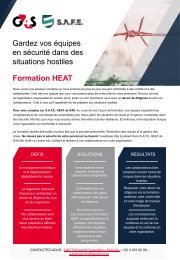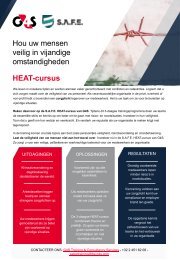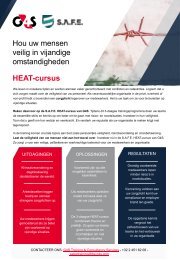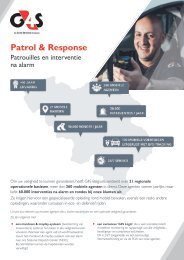G4S Academy Guide | Insider Threat
Create successful ePaper yourself
Turn your PDF publications into a flip-book with our unique Google optimized e-Paper software.
INSIDER THREAT:<br />
WHAT YOU NEED TO KNOW
TABLE OF CONTENTS<br />
1.<br />
2.<br />
4.<br />
5.<br />
7.<br />
8.<br />
12.<br />
Introduction: What is <strong>Insider</strong> <strong>Threat</strong>?<br />
What Are the Types of <strong>Insider</strong> <strong>Threat</strong>s?<br />
What are the Consequences of <strong>Insider</strong> <strong>Threat</strong>?<br />
Are Certain Businesses More Vulnerable to <strong>Insider</strong> <strong>Threat</strong>?<br />
Why Is <strong>Insider</strong> <strong>Threat</strong> So Challenging to Protect Against?<br />
How Do We Mitigate <strong>Insider</strong> <strong>Threat</strong>?<br />
Want to Protect Against <strong>Insider</strong> <strong>Threat</strong>?
INTRODUCTION: WHAT IS INSIDER THREAT?<br />
Picture a security threat. You think of an attacker<br />
coming from the outside, right? But what if the attack<br />
comes from within? <strong>Insider</strong> threats are a serious<br />
security risk we can’t ignore.<br />
An insider threat is someone who exploits their<br />
authorised access for unauthorised purposes. They<br />
can get their hands on protected, valuable areas<br />
and information.<br />
According to Verizon’s 2021 Data Breach<br />
Investigations Report, insiders caused 22% of security<br />
incidents. These incidents cost organisations millions.<br />
They also lead to exposure of sensitive customer and<br />
company data.<br />
A global cybersecurity study reported that insider<br />
threats cost an average of $15.4 million per year.<br />
Plus, over the last two years, the cost and frequency<br />
of insider threats has increased. This problem is not<br />
going away, and it’s getting worse.<br />
In this paper, we’ll look at insider threats and their<br />
many different aspects. Then, we’ll share some of<br />
the best practices and strategies we’ve found for<br />
combating this type of threat.<br />
1
WHAT ARE THE TYPES OF INSIDER THREATS?<br />
<strong>Insider</strong> threats are a diverse category of risks<br />
and attacks. <strong>Insider</strong>s can have different levels of<br />
motivation, awareness, access levels and intent.<br />
So, what are the different types of insider threats?<br />
Even though each case of insider attack is unique,<br />
we can group the attackers into a few categories.<br />
Understanding the motives and types can be key for<br />
prevention and mitigation.<br />
Here are the main different types of insider threats<br />
and their motivations.<br />
THE MALICIOUS INSIDER<br />
The Malicious <strong>Insider</strong> is someone who uses<br />
their access privileges on purpose to cause harm. They<br />
are often motivated by financial gain. Or, sometimes<br />
they are stealing company data to gain a competitive<br />
edge for a new venture. Usually, they are a lone wolf<br />
who acts on their own without any other influences.<br />
For example, a system administrator or database admin<br />
may abuse their high level of privilege. They could<br />
access valuable items, sensitive information or money.<br />
This is often difficult to prevent. This person is<br />
someone the company once trusted with sensitive<br />
information and access. But, something happened to<br />
make this staff member feel disgruntled and aggrieved.<br />
They want to “get even”, due to unfair termination,<br />
a lack of recognition or some other slight. Or, they<br />
may be someone who suddenly finds themselves in<br />
difficult circumstances in their personal life. In this<br />
case, desperation weakens their personal resilience<br />
and leads them to commit malicious acts.<br />
THE CARELESS HAZARD<br />
The Careless Hazard creates a vulnerability<br />
due to incompetence or negligence. This is more<br />
common than you might think. In fact, according to<br />
a 2019 report, careless behaviour causes two thirds<br />
(64%) of insider threats.<br />
An example could be an employee who forgets to<br />
log out of their work account on a public computer.<br />
This leaves it vulnerable for others to access. Or,<br />
someone who accidentally loses a flash drive that<br />
contains sensitive information. It’s easier than you<br />
think to mistype an email address and send sensitive<br />
information to the wrong person.<br />
Careless Hazards can also be unaware that they<br />
are being taken advantage of by others. They might<br />
download malware, give information to scammers or<br />
click on a link in a phishing email. They might even<br />
allow someone to “piggyback” through a secure<br />
entrance point. It’s as easy as not paying attention to<br />
the person entering behind them.<br />
They can also be someone who believes that they are<br />
exempt from security policies. For example, they may<br />
try to bypass security or skip a procedure because<br />
it takes too long. This type of cutting corners leaves<br />
data and resources vulnerable.<br />
2
Although the Careless Hazard may be unaware, their<br />
actions are still harmful to the organisation.<br />
THE IMPOSTOR<br />
The Impostor is someone from outside<br />
the organisation. They gain access by posing as a third<br />
party who gets temporary access to the facilities. For<br />
example, they might be a contractor or a consultant.<br />
Like a Trojan Horse, they gain access to the<br />
organisation with false good intentions. Then, once<br />
inside, they use their access to sabotage, corrupt,<br />
destroy or steal. They can be hard to catch, because<br />
once they have caused the damage they can disappear.<br />
challenging personal circumstances, which may<br />
include addiction, debt or medical issues. Often,<br />
the scammer will be manipulating many insiders at<br />
once. They can be enabling theft of property, data,<br />
espionage or any combination.<br />
As scammers become more sophisticated, they learn<br />
how to press all the right buttons. They can convince<br />
even high level stakeholders within an organisation to<br />
reveal information. When a person with such a high<br />
access level gets turned into an undercover saboteur,<br />
the company can suffer major losses.<br />
They might even be someone who gained access a<br />
while ago and is still able to use their credentials.<br />
Always change passwords, update key cards and<br />
provide guests with access credentials that expire.<br />
THE UNDERCOVER SABOTEUR<br />
The Undercover Saboteur is someone who<br />
has been “turned” by the malicious influence of a third<br />
party. They are colluding with someone outside of the<br />
company, using their access in exchange for something<br />
else of value.<br />
In this situation, the scammer often appeals<br />
to weaknesses in human nature such as greed,<br />
anger or a desire for fame and recognition. They<br />
may target someone who is desperate due to<br />
3
WHAT ARE THE CONSEQUENCES OF INSIDER THREAT?<br />
<strong>Insider</strong> threats are quite dangerous. The insider has<br />
access to the innermost levels of the company, and<br />
they can exploit this vulnerability in very harmful<br />
ways. So, what can insiders access, and what can they<br />
do with it?<br />
The consequences of insider threat depend on the<br />
goals of the insider and the types of assets they are<br />
targeting. There are four main types of assets an<br />
insider can target within an organisation:<br />
• People: The people who work within an<br />
organisation.<br />
• Property: The physical property owned or<br />
controlled by the organisation.<br />
• Information: Information about the company<br />
or its customers.<br />
• Reputation: The company’s professional<br />
reputation in the public sphere.<br />
When they get their hands on the above valuable<br />
assets, the perpetrator of the insider threat often<br />
wants to:<br />
• Obtain: Take the assets for their own purposes<br />
• Damage: Disable the assets to sabotage a<br />
competitor<br />
• Destroy: Erase or get rid of the items<br />
completely<br />
• Deny/Control: Restrict access to the assets.<br />
For example, if an intruder accesses information, they<br />
could expose those secrets to competitors. Or, they<br />
could leak customer data to ruin the reputation of<br />
the brand. Or, the insider might steal valuable items<br />
so that they can sell them for a profit.<br />
And of course, a more complex insider attack may<br />
involve doing more than one of these things to many<br />
different types of assets. There are infinite ways an<br />
insider can harm an organisation with their actions,<br />
whether intentional or unintentional. It’s important<br />
to be wide-ranging and thorough when it comes to<br />
developing strategies to prevent these types of attacks.<br />
Did you know?<br />
The damages caused by an internal threat are often much<br />
more expensive than those caused by outside attackers.<br />
Based on Ponemon Institute’s 2020 Cost of <strong>Insider</strong><br />
<strong>Threat</strong>s study, the global average cost of an insider<br />
threat was $11.45 million. The average cost of a data<br />
breach over the same period was $3.86 million.<br />
4
ARE CERTAIN BUSINESSES<br />
MORE VULNERABLE TO<br />
INSIDER THREAT?<br />
Are there any particular industries that are more<br />
vulnerable to insider threat? The answer depends<br />
on the value of the assets (people, property,<br />
information, reputation) within the company.<br />
For example, a lot that holds a pile of sand probably isn’t<br />
a target. But, a data centre attracts a high level of threat<br />
due to the value of the personal information there.<br />
The type of industry also affects which sort of insider<br />
threat is most prevalent. For example, stealing data<br />
to gain an edge is very common in competitive<br />
industries such as entertainment and finance. Some<br />
industries are more vulnerable to sabotage, while<br />
others have more high value items that are targets<br />
for theft.<br />
According to the 2022 Cost of <strong>Insider</strong> <strong>Threat</strong>s<br />
Global Report, the financial and professional services<br />
industry has the highest cost per incident. This<br />
includes a range of companies such as consultancy<br />
and accounting firms.<br />
5
WHY IS INSIDER THREAT SO CHALLENGING TO<br />
PROTECT AGAINST?<br />
What makes insider threats different than external<br />
threats? Why are these types of threats so much<br />
more difficult to prevent?<br />
There are a few reasons. Here are some of the<br />
factors that make insider threat a particularly<br />
challenging problem to solve.<br />
MANY SECURITY MEASURES<br />
FOCUS ON EXTERNAL THREAT<br />
Picture the typical traditional security measures.<br />
CCTV cameras, access control, metal detectors,<br />
etc. They are all focused on external threats. By<br />
themselves, they are not always capable of identifying<br />
an internal threat coming from inside the company.<br />
<strong>Insider</strong> threats often catch organisations by<br />
surprise, because they don’t always come from<br />
where they might expect. Some organisations<br />
protect against external threats, but haven’t thought<br />
about internal threat.<br />
TECHNOLOGY HAS EVOLVED<br />
In the past, insider threats were mainly<br />
physical. Companies needed to watch for theft of<br />
items or of insiders infiltrating physical spaces. But<br />
these days insider threat can be completely virtual.<br />
With the rise of remote work, security threats<br />
have become even more complex. We need to<br />
think about protecting data and digital spaces from<br />
attackers who are able to access them remotely<br />
from anywhere in the world. According to the 2021<br />
<strong>Insider</strong> <strong>Threat</strong> Report by Cybersecurity <strong>Insider</strong>, 53%<br />
of cybersecurity professionals say detecting insider<br />
attacks has become harder since businesses shifted<br />
to the cloud.<br />
Technology also makes it easier for attackers to<br />
cover their tracks and protect themselves. This<br />
opens up the possibility of so many more different<br />
types of insider threats.<br />
INSIDER THREATS ARE ALWAYS<br />
EVOLVING<br />
Another important factor to keep in mind is that<br />
insider threats are always evolving. It’s a constant<br />
game of cat and mouse for any organisation or<br />
security firm to stay one step ahead of them.<br />
Hackers are always looking for new ways to<br />
infiltrate businesses. That could mean hacking<br />
technology or “turning” employees. They often<br />
prey on the worst qualities of others and are always<br />
developing a fresh new way to do this.<br />
It’s not enough to know the techniques scammers<br />
are currently using to infiltrate organisations. It’s<br />
also necessary to think ahead and figure out what<br />
their future techniques will be before they attack.<br />
To truly be successful in mitigating insider threat,<br />
we must always be several moves ahead.<br />
6
HOW DO WE MITIGATE INSIDER THREAT?<br />
So, how do we stay ahead of insider threat? What<br />
are the best strategies for preventing this type of<br />
treat, identifying it when it happens and stopping it<br />
in it’s tracks?<br />
As mentioned above, we aim to stay one step ahead<br />
of the threat and always predict their next move.<br />
We do that by using a variety of strategies, both<br />
physical and psychological.<br />
Here are a few of the ways we mitigate insider threats:<br />
CAREFULLY SCREENING AND<br />
VETTING STAFF<br />
As the old saying goes, “an ounce of prevention is<br />
worth a pound of cure.” The mitigation of insider<br />
threats starts with hiring trustworthy staff who will<br />
be less likely to act maliciously against the company.<br />
In the security industry, it is a proven best practice<br />
to conduct rigorous background checks for every<br />
team member. Yet, sometimes that’s not enough.<br />
Employees who have had no prior incidents in their<br />
background can still get turned when they are on<br />
the inside. Or, they can become disgruntled and<br />
seek revenge.<br />
To take the screening and vetting process even<br />
further than the typical background check, consider<br />
conducting psychometric evaluations. These tests<br />
screen for the “Dark Triad” of personality traits:<br />
Narcissism, Machiavellianism and Psychopathy.<br />
• Narcissism: People who believe they are<br />
superior to others and are often selfish,<br />
arrogant and obsessed with themselves.<br />
• Machiavellianism: People who are<br />
manipulative and willing to deceive and hurt<br />
others in order to get what they want.<br />
• Psychopathy: People who are emotionally<br />
volatile and don’t experience empathy or<br />
remorse when they hurt others.<br />
These dark triad traits are effective predictors of<br />
job performance. People who have this Dark Triad<br />
of traits are more likely to exploit others, even<br />
close family or work colleagues, to get ahead.<br />
This is why it’s so important to screen for<br />
these personality traits within the psychometric<br />
assessment process. Considering how much damage<br />
one person with these traits can do within an<br />
organisation, your organisation can’t afford not to.<br />
UNDERSTANDING HUMAN<br />
PSYCHOLOGY<br />
There’s a certain comfort in outside threats. We<br />
can see them coming and we have alarms in place to<br />
stop them. But insider threats are more like a game<br />
of “Among Us”. Everyone claims to be innocent.<br />
The challenge is to figure out who’s lying.<br />
That’s why part of mitigating insider threat is<br />
understanding the human psychology behind their<br />
7
strategies. We dedicate time to learning about the<br />
psychological complexities of these attacks.<br />
Most scammers and malicious insiders are charming.<br />
They have the right skills to convince others around<br />
them that they are innocent. They use gaslighting,<br />
deflection and dishonesty to cover their tracks.<br />
But once you understand the psychology behind<br />
this type of scam, you’ll start to recognise patterns<br />
in behaviour. It will be easier to see behind the<br />
“theatre” and spot people for who they really are.<br />
SETTING UP ACCESS CONTROL<br />
Another crucial step for preventing<br />
insider threat is to set up levels of access control.<br />
At your premises, every access should be recorded.<br />
All employees, visitors and other personnel should<br />
get appropriate access for their status and role.<br />
It’s good safety protocol to restrict and control<br />
digital and physical access. It’s also important<br />
to compartmentalise sensitive knowledge and<br />
information. This sensitive data should only be<br />
shared on a need to know basis.<br />
Yet, if access control is too restrictive or difficult to<br />
use, staff may bypass it for convenience or it could<br />
restrict business. The ideal sweet spot provides the<br />
necessary control while still making it easy for those<br />
who need access to do their jobs.<br />
USING CCTV TECHNOLOGY<br />
CCTV technology is also a useful tool<br />
for preventing insider threat. When employees<br />
know the cameras are on them, it’s harder to do<br />
anything deceitful.<br />
For example, employees who transport money<br />
have cameras on them at all times. They count<br />
the money, pack the money and hand it over, all in<br />
front of a camera. In many situations, knowing that<br />
their actions are being recorded will affect their<br />
intentions to act.<br />
Cameras can also help with the issue of people<br />
using each others access cards. The CCTV footage<br />
will show who actually entered any specific area,<br />
and exactly what they did there.<br />
Of course, CCTV will never be enough by itself.<br />
It should be a part of a full security system and<br />
monitored by a well-trained team.<br />
MONITORING BEHAVIOUR<br />
Any significant change in staff behaviour<br />
can be a warning sign for insider threats. A modern<br />
AI security system can track this information and<br />
detect unusual activity.<br />
With historical data, you can create a baseline of<br />
“normal” behaviour for any employee. Once you<br />
know the baseline, you can flag any deviations<br />
from the norm.<br />
What behaviours should you watch out for? For<br />
example, you may notice:<br />
• An employee who was always on time for years,<br />
but has now been arriving late.<br />
8
• An employee who has been recently staying later<br />
than usual.<br />
• A staff member who logged in on an unusual day<br />
or time, or from a new location.<br />
• Someone with many failed password attempts on<br />
their account.<br />
• A staff member accessing areas of the premises<br />
with no obvious reason to be there.<br />
• An employee with a large number of data<br />
transfers or outbound communications.<br />
• An employee loitering for too long in a<br />
particular area.<br />
Of course, these behaviours themselves are not<br />
evidence of any wrongdoing. Flag them and look into<br />
them, but don’t jump to conclusions before hearing<br />
the whole story.<br />
For example, the staff member staying later after<br />
their shift may be waiting around for a bus. Or the<br />
person arriving late might be dropping their child<br />
off at a different school further away. Someone<br />
could be trying to access a room with with sensitive<br />
information. Or, they could have a crush on someone<br />
who works in that corridor and they want to say hi.<br />
Monitoring staff behaviour should be the beginning<br />
of a conversation. Talk to your team and find out<br />
the reasons behind these behaviours, so you can<br />
understand what’s going on. For this, it’s important<br />
to align with HR, as they are the ones who will know<br />
the employees best.<br />
SETTING UP SOLID SECURITY<br />
PROCEDURES<br />
Most accidental insider risk comes from negligence.<br />
In other words, things go wrong when staff don’t<br />
do things properly. This is why it’s so important to<br />
set up solid security procedures. When all external<br />
protections fail, internal procedures are often the<br />
only things left to protect you.<br />
For example, this might look like setting up a five<br />
step checklist for shutting down a lab or workspace.<br />
If this workspace contains valuable information or<br />
products, employees must secure those assets. The<br />
procedure should be clearly outlined, with no room<br />
for confusion. Also, train your employees often and<br />
refresh them on these procedures.<br />
Be sure to track these procedures too. There should<br />
always be a record of when they were carried out,<br />
and by whom. It may take a little extra time and<br />
thought to set this up at first, but it’s worth it.<br />
ENCOURAGING STAFF TO<br />
SPEAK OUT<br />
Train employees to detect risky behaviour among<br />
their colleagues and report it. Your team will spot<br />
more than you ever would on your own.<br />
Staff members need to feel safe and encouraged to<br />
speak up. Give them a confidential way to report, to<br />
avoid negative retaliation from colleagues.<br />
Of course, staff will only be willing to share<br />
information if they feel valued at the company.<br />
9
When employees are resentful or disgruntled, they<br />
may be unwilling to help. They will be more likely<br />
to turn a blind eye and think, “not my problem,”<br />
when they see something suspect.<br />
Which leads into our next strategy: boosting the<br />
health of the workplace culture.<br />
CREATING A HEALTHY<br />
WORKPLACE CULTURE<br />
As the saying goes, “rotten barrels make rotten apples.”<br />
Toxic workplaces foster dishonesty and mistrust.<br />
Disgruntled employees often want revenge on the<br />
employer who wronged them. This leaves your<br />
organisation vulnerable. Even terminated employees<br />
may still have information they can use to cause harm.<br />
So, keep a close eye on employee morale and listen<br />
to your team. Act with integrity and show them<br />
respect. Make them feel valued, pay them well and<br />
give them recognition for their hard work.<br />
Improving the culture of your workplace will not only<br />
help to reduce the risk of insider threat. It will also<br />
boost your bottom line. You’ll attract innovative top<br />
talent and they will be more productive. Plus, they<br />
will stick around - saving you time and money on<br />
recruiting and training.<br />
MONITORING FOR LEAKED<br />
PRODUCTS/DATA<br />
Another way to halt product theft is to keep an<br />
eye out for products that show up elsewhere. For<br />
example, a major clothing brand was experiencing an<br />
issue with theft from their warehouse and shipping<br />
locations. So, they monitored third party resale<br />
websites for an influx of their stolen products. They<br />
were able to identify the illegal resellers and shut<br />
them down.<br />
You can also keep your ear to the ground online.<br />
Look for any discussion of your brand on social<br />
media and online forums. You might find data or<br />
secrets being shared, or discussions by disgruntled<br />
potential saboteurs. This type of monitoring should<br />
be done regularly. It’s an important part of your<br />
security strategy.<br />
It’s especially important when it comes to data<br />
breaches. Often when data gets leaked, it takes<br />
businesses months to even notice the breach.<br />
According to a report from IBM, in 2022 it took an<br />
average of 277 days to identify and contain a data<br />
breach. That’s approximately nine months! The longer<br />
it takes to catch a data breach, the more money will<br />
be lost (not to mention the reputation damage.)<br />
Monitoring can help with this. When you notice<br />
a strange behaviour pattern, reach out and offer<br />
support. Encourage communication and show you<br />
care, and your team will have your back.<br />
10
WANT TO PROTECT<br />
AGAINST INSIDER THREAT?<br />
With the right training, a positive work environment<br />
and the latest technology, it is possible to reduce the<br />
risk of insider threat. The above best practices are a<br />
great start, but the list of strategies is not limited.<br />
When it comes to protecting your company against<br />
insider threats, it’s important to diversify your<br />
approach. Don’t rely on a single solution. Instead,<br />
take stock of the unique needs of your organisation.<br />
Create a system that combines several defences<br />
against insider attacks.<br />
To find out more about insider threat and get<br />
a custom consultation for your business, talk<br />
to an expert on the <strong>G4S</strong> team. Reach out<br />
to us today at www.<strong>G4S</strong>.com.<br />
11
VALUE CREATED<br />
TOGETHER<br />
CONTACT<br />
GET IN TOUCH WITH THE <strong>G4S</strong> TEAM – VISIT WWW.<strong>G4S</strong>.COM<br />
V1 OCTOBER 2022















